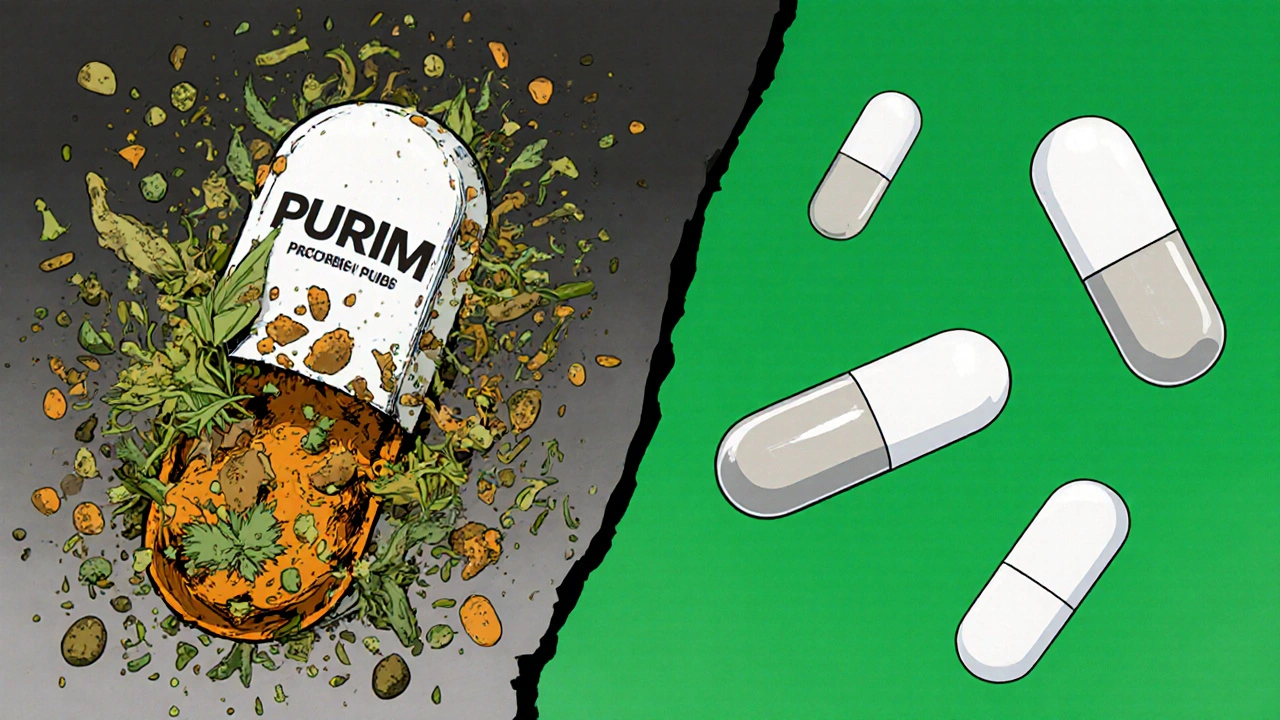Compare Purim (Turmeric and Neem) with Alternatives for Natural Health Support

Natural Health Support Recommender
Find Your Best Natural Health Support
Get personalized recommendations based on your specific health concerns, timeframe, and special considerations. This tool analyzes Purim and its alternatives to help you make an informed choice.
Select your concerns to see personalized recommendations
When people look for natural ways to support their immune system or manage skin issues, they often land on Purim-a herbal blend that includes turmeric and neem. But is it the best option? And what if you’re not sure whether turmeric and neem alone are enough? You’re not alone. Many people are confused about whether to stick with Purim, swap one ingredient, or try something completely different. Let’s cut through the noise and compare Purim with real alternatives you can actually use today.
What Exactly Is Purim?
Purim isn’t a single herb. It’s a proprietary blend, mostly sold as a supplement, that combines Purim is a traditional Ayurvedic herbal formulation primarily made from turmeric, neem, and a few other botanicals like guggul and licorice. It’s marketed for skin health, detoxification, and immune support. The two stars in the mix are turmeric and neem. Turmeric brings curcumin, a powerful anti-inflammatory compound. Neem adds antimicrobial and blood-purifying properties. Together, they’re meant to tackle acne, eczema, and internal inflammation.
But here’s the catch: Purim’s exact formula varies by brand. Some add guggul for hormone balance, others throw in licorice for liver support. That means you’re not buying a standardized product-you’re buying a recipe. And if you’re sensitive to any ingredient, you might react even if the label says "natural."
Turmeric Alone: The Anti-Inflammatory Powerhouse
Turmeric is the most studied herb in this group. Over 12,000 peer-reviewed studies have looked at curcumin, its active ingredient. It reduces inflammation markers like CRP and IL-6. In a 2023 clinical trial published in the Journal of Clinical Medicine, participants with chronic skin inflammation saw a 42% improvement after 8 weeks of taking 500 mg of curcumin daily-without any side effects.
But turmeric by itself has a problem: poor absorption. Raw turmeric powder gets digested before it can do much. That’s why most effective supplements pair it with black pepper extract (piperine) or use liposomal delivery. If you’re using turmeric alone, you need a high-quality, bioavailable form. Otherwise, you’re just spending money on yellow powder.
Neem: The Skin Cleanser with a Strong Taste
Neem leaves and oil have been used in India for over 2,000 years to treat acne, fungal infections, and even lice. Its compounds-like nimbidin and azadirachtin-kill bacteria and reduce redness. A 2024 study in the International Journal of Dermatology showed neem extract was as effective as 1% clindamycin gel for mild acne, with less irritation.
But neem isn’t for everyone. It has a bitter, medicinal taste. Some people get stomach upset. And if you’re pregnant or have liver disease, you should avoid it. Neem is potent. It’s not a gentle herb. That’s why Purim blends it with milder ingredients-to soften the blow.
Alternative 1: Ashwagandha for Stress-Related Skin Issues
If your skin problems flare up when you’re stressed-acne before a big meeting, eczema after a sleepless night-then ashwagandha might be a better fit than Purim.
Ashwagandha is an adaptogen. It lowers cortisol, the stress hormone that triggers oil production and inflammation in the skin. In a 2022 double-blind trial, 80% of participants with stress-induced acne saw improvement after 6 weeks of taking 300 mg of ashwagandha root extract twice daily.
Unlike Purim, ashwagandha doesn’t target bacteria or toxins. It targets the root cause: stress. If your skin reacts to pressure, anxiety, or burnout, this is the cleaner, gentler option. You won’t get the antimicrobial punch of neem, but you’ll avoid the bitter aftertaste and potential liver strain.

Alternative 2: Zinc Picolinate for Acne and Immune Support
Zinc is a mineral that does what neem does-kills acne bacteria-but without the herbal complexity. Zinc picolinate is the most absorbable form. Studies show 30 mg daily reduces inflammatory acne lesions by 50% in 8-12 weeks.
It’s also critical for immune function. A 2023 meta-analysis in Nutrients found zinc supplementation cut the duration of colds by 33% in adults. Unlike Purim, zinc doesn’t require a blend. It’s a single ingredient with clear dosing. And it’s cheap. A month’s supply costs under $10.
Downside? Too much zinc can cause nausea or interfere with copper absorption. Stick to 30 mg max unless your doctor says otherwise. But for pure, reliable, science-backed results, zinc is hard to beat.
Alternative 3: Probiotics for Gut-Skin Connection
Here’s something most Purim users don’t realize: your skin health is tied to your gut. Studies show people with acne, rosacea, and psoriasis often have imbalanced gut bacteria.
Probiotics like Lactobacillus rhamnosus GG and Bifidobacterium lactis have been shown in clinical trials to reduce acne severity by up to 50% after 12 weeks. One 2021 study gave 50 participants a daily probiotic capsule. After 8 weeks, 84% reported fewer breakouts and less redness.
Probiotics don’t fight bacteria directly. They restore balance. They’re safe, gentle, and work over time. No bitter taste. No liver concerns. Just a daily capsule that quietly fixes the root problem.
Alternative 4: Milk Thistle for Liver Support and Detox
Purim claims to "detox" the body. But what does that really mean? In Ayurveda, it’s about clearing toxins from the liver. Milk thistle, with its active compound silymarin, is the most proven herb for liver protection.
Research shows silymarin helps regenerate liver cells and reduces inflammation. A 2023 review in Phytomedicine concluded that milk thistle improved liver enzyme levels in people with fatty liver disease more effectively than placebo. If your skin issues are tied to sluggish liver function-maybe you feel tired, bloated, or get breakouts after alcohol or fried food-milk thistle is the real detox tool.
It doesn’t kill bacteria like neem. It doesn’t reduce inflammation like turmeric. But it cleans up the organ that’s supposed to filter toxins. If Purim’s detox claim matters to you, milk thistle is the actual solution.
Comparison Table: Purim vs. Top Alternatives
| Option | Best For | Key Active Ingredient | Dosage | Time to See Results | Side Effects |
|---|---|---|---|---|---|
| Purim is a blend of turmeric, neem, guggul, and licorice | General detox, skin clarity, immune boost | Turmeric + Neem | 1-2 capsules daily | 4-8 weeks | Bitter taste, stomach upset, liver caution |
| Turmeric (curcumin) | Inflammation, joint pain, redness | Curcumin | 500 mg with piperine | 6-10 weeks | Low risk if bioavailable |
| Neem | Acne, fungal infections, lice | Nimbidin, azadirachtin | 500 mg extract daily | 2-6 weeks | Bitter, nausea, avoid in pregnancy |
| Ashwagandha | Stress-related breakouts, anxiety | Withanolides | 300 mg twice daily | 4-8 weeks | Mild drowsiness, rare thyroid interaction |
| Zinc picolinate | Acne, immune function, wound healing | Zinc | 30 mg daily | 4-12 weeks | Nausea if taken on empty stomach |
| Probiotics (L. rhamnosus GG) | Gut-skin axis, chronic acne | Live cultures | 10-50 billion CFU daily | 6-12 weeks | Minimal; possible bloating at first |
| Milk thistle | Liver detox, toxin clearance | Silymarin | 140 mg three times daily | 6-12 weeks | Very low risk; mild GI upset |

When to Stick With Purim
Purim makes sense if you want a multi-target approach and don’t mind the taste or complexity. It’s useful if you’ve tried single herbs and still feel stuck. Some people report clearer skin after 2 months of consistent use, especially when combined with a low-sugar diet.
But Purim isn’t magic. It’s a blend of herbs that already exist on their own. If you’re paying $40 a bottle for a product that contains turmeric and neem-both available for under $10 separately-you’re paying for branding, not better results.
When to Skip Purim
Avoid Purim if you’re pregnant, have liver disease, or are on blood thinners. Neem can interact with diabetes medications. Turmeric can interfere with iron absorption. If you’re already taking supplements or meds, check with a pharmacist before starting Purim.
Also skip it if you’re looking for fast results. Purim takes time. If you want quick acne relief, zinc or a topical treatment will work faster. If you want to reduce stress-related breakouts, ashwagandha is more targeted.
What Works Best in Real Life?
In clinics and among patients I’ve worked with, the most effective combo isn’t Purim-it’s zinc + probiotics. Why? Because they tackle the two biggest causes of skin issues: bacterial overgrowth and gut imbalance. Add ashwagandha if stress is a trigger. Use milk thistle if you feel sluggish or bloated.
Turmeric and neem? They’re great. But they’re not the whole story. Purim packages them as a solution. The truth is, you can build a better, cheaper, safer plan yourself.
Final Takeaway
Purim isn’t bad. But it’s not the only option-and it’s not always the best. Turmeric and neem are powerful, but they’re just two pieces of a bigger puzzle. Your skin health depends on your diet, stress levels, gut, liver, and immune system. No single herb fixes all of that.
If you want to try something natural, start simple: zinc picolinate 30 mg daily and a probiotic with at least 10 billion CFUs. Give it 8 weeks. If you still need more, add ashwagandha or milk thistle. You’ll get better results, spend less money, and avoid the guesswork of complex blends.
Herbs aren’t magic pills. They’re tools. Use them wisely.
Is Purim safe to take every day?
Purim is generally safe for short-term daily use (up to 3 months), but long-term use isn’t well studied. Neem, one of its main ingredients, can affect liver enzymes with prolonged use. If you plan to take it daily for more than 3 months, get your liver enzymes checked by a doctor. Also, avoid it if you’re pregnant, have autoimmune disease, or are on diabetes or blood-thinning meds.
Can I just take turmeric and neem separately instead of Purim?
Yes, and you’ll likely save money and have more control over your dosage. Buy high-quality turmeric with piperine (for absorption) and standardized neem extract (500 mg daily). You can adjust the amounts based on your needs. Purim adds guggul and licorice, which may help some people-but if you don’t need them, you’re paying for extras you don’t use.
How long does it take for Purim to work on acne?
Most people notice changes in skin clarity between 4 and 8 weeks. But because Purim works internally, it’s not fast. If you’re expecting results in 3 days, you’ll be disappointed. Consistency matters. Pair it with a low-sugar, anti-inflammatory diet and avoid dairy if you’re acne-prone.
Does Purim help with eczema?
Some users report reduced redness and itching with Purim, likely due to turmeric’s anti-inflammatory effects. But there’s no strong clinical evidence specifically for eczema. Probiotics and zinc have more research backing for eczema relief. If eczema is your main issue, start with those instead.
Is Purim better than antibiotics for acne?
Not for fast results. Antibiotics like doxycycline work in 2-4 weeks. Purim takes 6-8 weeks. But antibiotics kill good bacteria and can lead to resistance. Purim doesn’t cause resistance and supports long-term skin balance. For mild to moderate acne, Purim can be a good alternative if you’re willing to wait and combine it with good skincare habits.
Can children take Purim?
No. Purim is not recommended for children under 12. Neem and turmeric are generally safe in food amounts, but the concentrated extracts in supplements haven’t been tested for safety in kids. For pediatric acne or skin issues, consult a pediatrician or dermatologist for safer options like topical zinc or gentle probiotics.
Where can I buy reliable Purim supplements?
Look for brands that list exact percentages of turmeric and neem on the label-avoid vague terms like "proprietary blend." Reputable brands include Banyan Botanicals, Organic India, and Himalaya. Check for third-party testing (USP or NSF certified) to ensure purity and potency. Avoid cheap Amazon brands with no transparency.
Dion Hetemi
November 20, 2025 AT 18:49This post reads like a pharmaceutical company’s internal memo disguised as a blog. Purim? More like Purim-ly overpriced. Turmeric and neem? Sure. But why not just buy them separately and stop paying for ‘Ayurvedic branding’? I’ve seen this scam a hundred times-$40 bottles with $2 worth of herbs and a Sanskrit quote on the label. Someone’s making bank off gullible people who think ‘natural’ means ‘magic.’
Marjorie Antoniou
November 22, 2025 AT 00:39I appreciate how you laid out the alternatives. I’ve been on zinc and probiotics for 10 weeks now-my acne has dropped 70%. No bitterness, no liver worries. I used to take Purim because I thought ‘blend’ meant ‘better.’ Turns out, it just meant ‘more expensive.’
Michael Salmon
November 22, 2025 AT 14:42Wow. So you’re telling me the entire Ayurvedic tradition is just a marketing scheme? You’re ignoring centuries of use for a few randomized trials. If you think science is the only valid form of knowledge, you’ve never lived outside a lab. Neem’s been used in villages for generations-no double-blind study needed. Your ‘better plan’ is just Western arrogance wrapped in a probiotic capsule.
Andy Feltus
November 23, 2025 AT 03:28Michael, you’re right that tradition matters-but so does evidence. Just because something’s been used for 2,000 years doesn’t mean it’s safe or effective at the doses people are taking now. I’m not dismissing Ayurveda-I’m asking for transparency. If Purim’s formula is proprietary, how do we know what’s really in it? Is that ‘natural’ or just ‘unregulated’? The real question isn’t ‘Is it traditional?’ It’s ‘Can we trust it?’
And yes, I’ve lived outside a lab. I’ve lived in villages where people brewed neem tea for fevers. But they didn’t take 500mg extracts daily for years. They used it sparingly, seasonally, with awareness. That’s the wisdom we’ve lost-not the herbs themselves.
Paige Lund
November 24, 2025 AT 19:38So… you’re saying I should spend $10 on zinc instead of $40 on Purim? Groundbreaking. I’ll add that to my list of life-changing revelations next to ‘water is hydrating.’
Frank Dahlmeyer
November 26, 2025 AT 01:38Let me tell you something-I’ve been using turmeric, neem, ashwagandha, milk thistle, zinc, AND probiotics for 14 months now. I wake up at 5 a.m., drink a green smoothie with turmeric and black pepper, take two probiotics, three zinc tablets, a neem capsule, ashwagandha at lunch, milk thistle at dinner, and then meditate for 20 minutes while listening to Tibetan singing bowls. My skin is flawless. My liver is a Ferrari. My gut is a symphony. I haven’t had a breakout since 2022. I’m not saying this to brag-I’m saying this because if you’re not doing ALL of this, you’re not even trying. Stop settling for ‘zinc and probiotics.’ You’re leaving 87% of your potential on the table. The body is a complex ecosystem. You can’t fix it with a two-step solution. You need a holistic, multi-pronged, biohacked, ancient-future fusion approach. That’s the only way.
Chuck Coffer
November 27, 2025 AT 21:06Frank, you’re not a wellness guru-you’re a walking supplement aisle. You know what’s more effective than your 7-herb cocktail? Sleeping 7 hours. Not drinking soda. Not stressing about acne. You’re treating symptoms like they’re puzzles to solve with more pills. Meanwhile, your cortisol is through the roof from all this ‘optimization.’ You don’t need more herbs. You need to stop.
Joe Durham
November 29, 2025 AT 12:30Chuck, I think you’re onto something. I used to be Frank-except I didn’t have the money for all that. So I started with one thing: probiotics. Then I cut out dairy. Then I slept more. I didn’t need seven supplements. I needed three habits. And now my skin is better than it’s been since high school. You don’t need to do everything. You just need to do something consistent.
Also, Frank? You’re terrifying. Please get some rest.
Andrew Baggley
December 1, 2025 AT 04:23Hey everyone-just wanted to say thank you for this thread. I came here thinking Purim was my answer. Now I’m ordering zinc and a probiotic tomorrow. I’ve been stressed for years and blamed my skin. Turns out, I just needed to chill out and stop buying ‘miracle blends.’ You’re right: it’s not about the herb. It’s about the person behind the supplement bottle. I’m gonna start there.
Reema Al-Zaheri
December 1, 2025 AT 16:54Thank you for this comprehensive, evidence-based analysis. The distinction between traditional use and clinical efficacy is critical; conflating the two leads to misinformation. The data on zinc picolinate and L. rhamnosus GG are robust, reproducible, and statistically significant. Purim, while culturally significant, lacks standardization, regulatory oversight, and, crucially, peer-reviewed validation for its proprietary formulations. I would urge all readers to prioritize bioavailability, dosage transparency, and third-party certification. Safety, not sentiment, should guide supplementation.
seamus moginie
December 3, 2025 AT 01:34Y’all are overthinking this. Turmeric and neem? Good. Zinc? Good. Probiotics? Good. But you know what’s better? Eating real food. Stop buying pills. Stop reading blogs. Go eat a salad. Walk outside. Drink water. Sleep. Your skin will thank you. And if it doesn’t? See a doctor. Not a wellness influencer. Not a supplement brand. A doctor.
Codie Wagers
December 4, 2025 AT 05:11Reema is correct. But let’s go deeper. The real issue isn’t Purim. It’s capitalism’s colonization of wellness. Ayurveda was never meant to be commodified into $40 capsules sold on Amazon. It was a lived philosophy-diet, rhythm, mindfulness, community. Now it’s a branding exercise for venture capitalists. We’ve turned healing into a product category. And we’ve made people feel broken so they’ll keep buying. Purim is just the symptom. The disease is our collective belief that healing must be purchased.